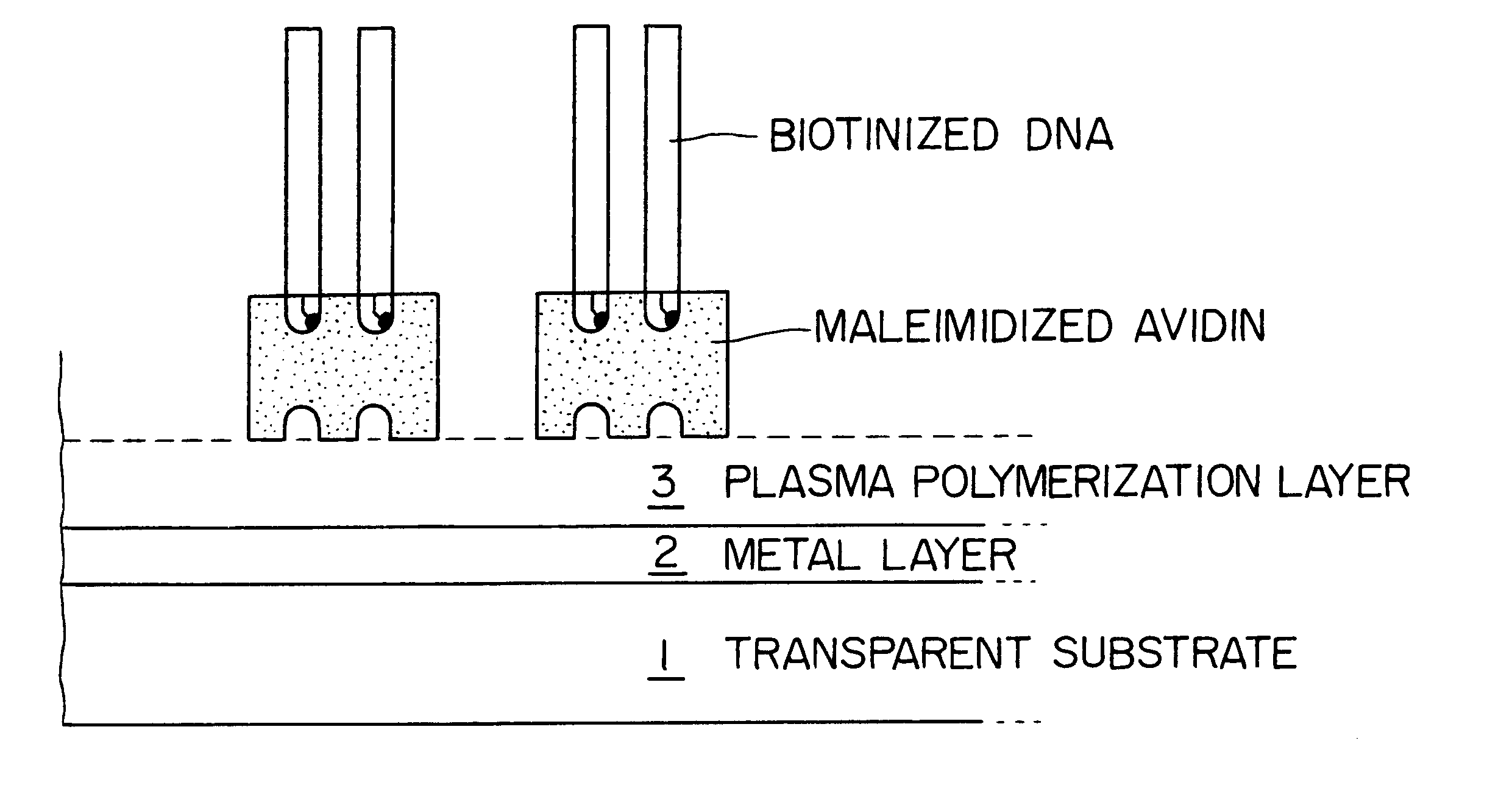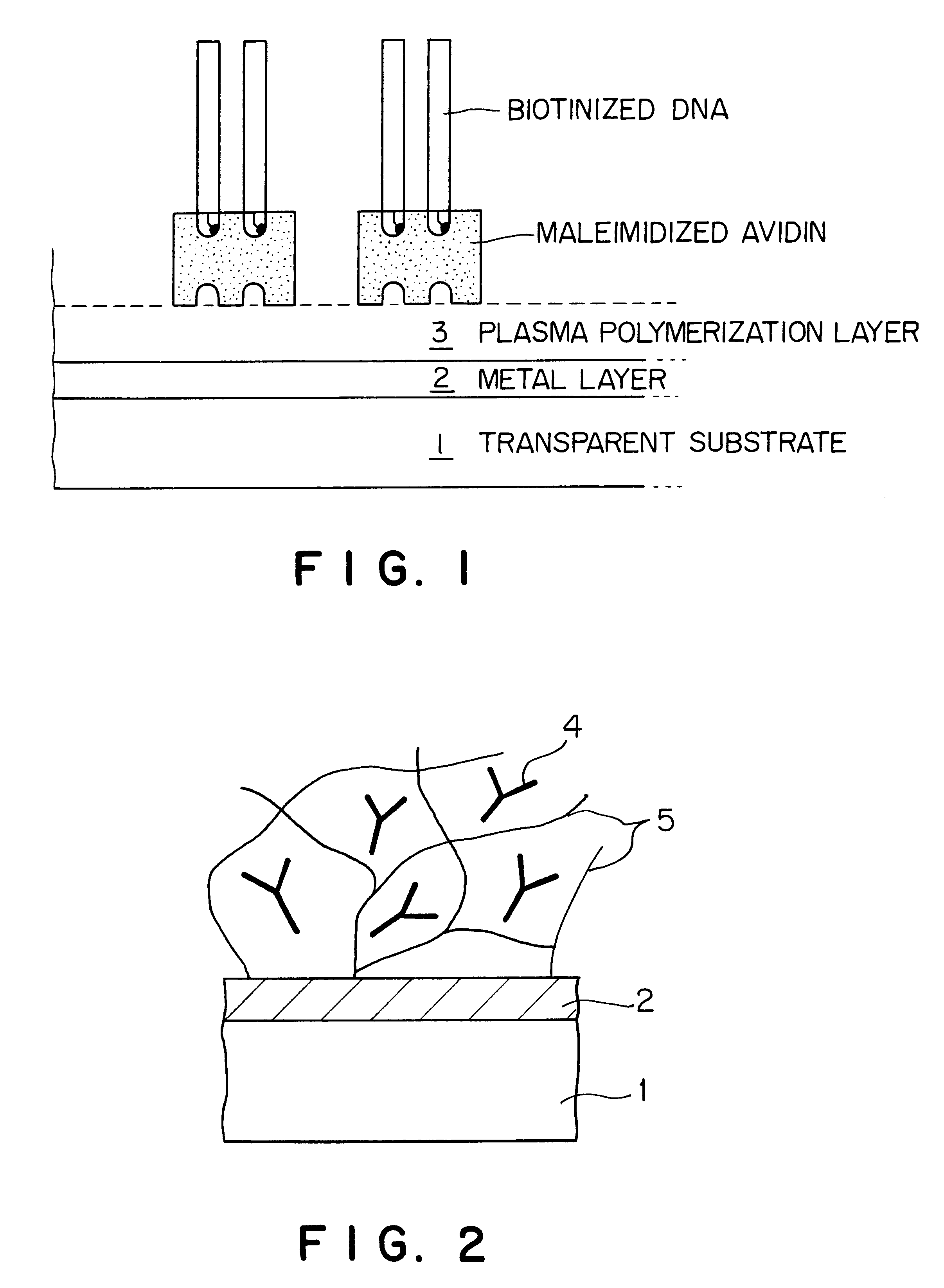Measuring chip for surface plasmon resonance biosensor and method for producing the same
a surface plasmon and biosensor technology, applied in the direction of liquid gas reaction, gas-gas reaction process, instruments, etc., can solve the problems of insufficient detection of inability to detect surface plasmon phenomena of the medium, and inability to use conventional methods
- Summary
- Abstract
- Description
- Claims
- Application Information
AI Technical Summary
Benefits of technology
Problems solved by technology
Method used
Image
Examples
example 1
A measuring chip having layers shown in FIG. 1 on an optical recognition part was constructed.
A glass plate with a thickness of 0.15 mm (18 mm.times.18 mm) was used for a transparent substrate. A chrome layer and then a gold layer were deposited on this transparent substrate by sputtering. The sputtering was carried out at 100 W for 40 seconds for the chrome layer and at 100 W for 2 minutes and 30 seconds for the gold layer. The resulting chrome layer was 40 angstroms thick and the resulting gold layer was 500 angstroms thick.
A plasma polymerization layer was formed on the metal layers. An apparatus as shown in FIG. 7 was used for plasma polymerization. Ethanedithiol was used as a monomer material for the plasma polymerization layer to introduce a thiol group. Conditions for plasma polymerization were as follows:
Flow volume of monomer material: 15 sccm
Temperature: 15.degree. C.
Pressure: 4.7 Pa
Discharge electric power: 20 W
Discharge frequency: 10 MHz, FM modulation
Duration of dischar...
example 2
The same apparatus and method as in Example 1 were used.
Acetonitrile was used as a monomer material for the plasma polymerization layer. Conditions for plasma polymerization were as follows:
Flow volume of monomer material: 1.5 sccm+Ar dilution 15 (sccm)
Temperature: room temperature
Pressure: 4.7 Pa
Discharge electric power: 80 W
Discharge frequency: 13.56 MHz
Duration of discharge: 15 seconds.
Under the conditions described above, a plasma polymerization layer was formed. The sensor chip was mounted on the cartridge block of the surface plasmon resonance biosensor, 5% glutaraldehyde was poured through a flow route into the measuring cell at a flow rate of 5 .mu.l / min for 10 minutes and avidin (concentration: 20 .mu.g / ml) was also poured at a flow rate of 5 .mu.l / min to immobilize for 60 minutes. 10 .mu.M biotin-labeled probe RNA were then poured at a flow rate of 1 .mu.l / min to immobilize the probe RNA for 10 minutes. DNA (7.5.times.10.sup.-7 M) having a DNA sequence complementary to thi...
example 3
The same apparatus and method as in Example 1 were used.
Conditions for plasma polymerization layer formation were the same as in Example 2.
Under the conditions described above, a plasma polymerization layer was formed.
The sensor chip was mounted on the cartridge block of the surface plasmon resonance biosensor, 5% glutaraldehyde was poured through a flow route into the measuring cell at a flow rate of 5 .mu.l / min for 10 minutes and streptoavidin (concentration: 20 .mu.g / ml) was also poured at a flow rate of 5 .mu.l / min to immobilize for 60 minutes. 10 .mu.M biotin-labeled probe RNA was then poured at a flow rate of 1 .mu.l / min for 10 minutes to immobilize the probe RNA. DNA (7.5.times.10.sup.-7 M) having a DNA sequence complementary to this probe RNA was introduced and after the reaction, a signal of about 375 RU was obtained.
It was confirmed by the XPS analysis that the resulting membrane has a primary amine.
PUM
| Property | Measurement | Unit |
|---|---|---|
| Transparency | aaaaa | aaaaa |
Abstract
Description
Claims
Application Information
 Login to View More
Login to View More - R&D
- Intellectual Property
- Life Sciences
- Materials
- Tech Scout
- Unparalleled Data Quality
- Higher Quality Content
- 60% Fewer Hallucinations
Browse by: Latest US Patents, China's latest patents, Technical Efficacy Thesaurus, Application Domain, Technology Topic, Popular Technical Reports.
© 2025 PatSnap. All rights reserved.Legal|Privacy policy|Modern Slavery Act Transparency Statement|Sitemap|About US| Contact US: help@patsnap.com



